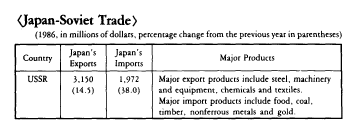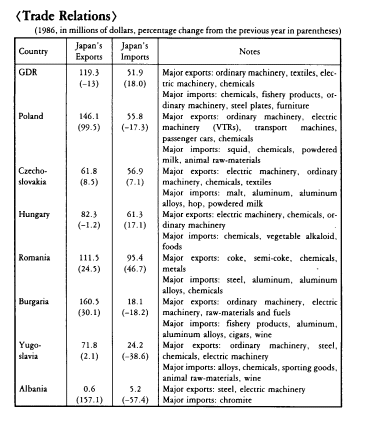
Section 6. USSR and Eastern Europe
(1) USSR
A. Northern Territory Issue
(a) Then Foreign Minister Abe visited the Soviet Union in late May 1986 to facilitate the regular bilateral foreign ministers' consultations and negotiations on a peace treaty including the territorial issue, which were resumed on Soviet Foreign Minister Shevardnadze's visit to Japan in January. At talks in Moscow with Shevardnadze, Abe made the following points clearly and in detail to describe Japan's basic stance on the Northern Territory issue, including its legal and historical aspects:
1) The Soviet Union promised in the 1956 Japan-Soviet Joint Declaration to return the Habomai Island group and Shikotan Island to Japan after conclusion of a bilateral peace treaty. The reversion to Japan of two other islands -Kunashiri and Etorufo- has been subjected to peace treaty negotiations under the talks on normalization of bilateral ties, the Matsumoto-Gromyko letters and provisions of the Joint Declaration. The Soviet Union has insisted that Japan's signing of a new security treaty with the United States in 1960 caused a change of the situation involving the 1956 Joint Declaration. But any country must not be allowed to change its serious international commitment unilaterally. When the Joint Declaration was signed, the fact is that a Japan-U.S. security treaty already existed with foreign forces stationed in Japan.
2) The 1973 Japan-Soviet Joint Communique says the two countries should solve problems pending since World War II and conclude a peace treaty. Then Japanese Prime Minister Kakuei Tanaka and then Soviet General Secretary Leonid I. Brezhnev at their talks confirmed that the pending problems included the four island issue. The confirmation came after the Soviet Union's promise to return the Habomais and Shikotan Island to Japan after the conclusion of the peace treaty, and so, reaffirmed the agreement in the 1956 Joint Declaration to discuss the reversion to Japan of Kunashiri and Etorofu Islands as well as peace treaty negotiations.
3) The Northern islands had never become any foreign territory and are not included in the Kurile Islands as stipulated in the San Francisco peace treaty.
4) Solution of the territorial issue and conclusion of the peace treaty would have the decisive significance to develop Japan-Soviet relations.
In response to the points made by Abe, Shevardnadze said he was not to repeat details of the Soviet stance because they were specified at the January talks. He said Japan arose as an ally of the United States from the 1950s to 1960s to cause a change in the situation. This fact has remained unchanged, he said. Schevardnadze also said the time was not ripe for conclusion of the peace treaty because of the Japanese stance on the territorial issue. In the circumstances, he said, the Soviets had proposed to conclude a bilateral treaty of good neighborhood and cooperation.
Foreign Minister Abe also held two hours of talks with General Secretary Gorbachev and told him that the solution of the Northern Territory issue and the conclusion of the peace treaty would be the most important for the future Japan-Soviet relations. The general secretary said the issue concerned the principle of border nonaggression. The Soviet territorial right to the islands had been legally accepted as a result of World War II and the issue had been solved in the world which changed after the war, he said. But Gorbachev added the Soviets would continue dialogue on the matter.
The Soviets thus maintained their hardline stance on the matter during Abe's visit to Moscow and indicated no shift from their previous attitude. But the two sides agreed to hold peace treaty negotiations including the territorial issue at the next regular bilateral foreign ministers' tions to take place in Tokyo.
(b) Foreign Minister Kuranari met with his Soviet counterpart Shevardnadze on the occasion of September's United Nations General Assembly session, and told him that leaving the Northern Territory issue pending would not benefit both countries, that the absence of a peace treaty between the two countries more than 40 years after the war was extremely abnormal, and that Japan strongly hopes to have the abnormality corrected. Kuranari also demonstrated Japan's basic stance on the territorial issue to the world in his address to the United Nations General Assembly.
(c) The Japanese government also has strongly been demanding the reversion of all the four northern islands to Japan in order to solve the territorial issue at all other occasions like the bilateral working-level consultations in Moscow in November 1986.
B. Issue of Gorbachev's Japan Visit
The Japanese and the Soviet foreign ministers at their regular consultations in January and May 1986 agreed in principle to exchange the top leader visits. Considering that no top Soviet leader has visited Japan in spite of the past four visits to the Soviet Union by Japanese prime ministers, Japan has taken a stance that Gorbachev should first make a trip to Japan. Furthermore, Gorbachev himself has expressed his willingness to visit Japan. In the circumstances, Foreign Minister Kuranari proposed to the Soviets in August 1986 that General Secretary Gorbachev visit Japan within 1986 if possible, or by late January 1987 at the latest. But the Soviets failed to specify any schedule for Gorbachev's visit to Japan until early December. Then the Japanese and the Soviet governments confirmed that Gorbachev's visit to Japan would not be able to realize by January. The Soviets are expected to propose a specific schedule for the general secretary's visit to Japan in the future.
C. Issue of Visit to Graves
Based on the regular Japan-Soviet foreign ministers' consultations in May, the two countries agreed in early July that Japanese people would be allowed to visit graves in the Northern Territories only with identification cards, without passports or visas. The agreement came in a manner which did not hurt Japan's position in the Northern Territory issue. In August, Japanese people visited graves on the Northern Territories (Suisho Island of the Habomais and Shikotan Island) for the first time in 11 years. Japanese visits to graves were also made for Karafuto from late July to early August and to the Soviet mainland in September. Soviet people visited Japanese graves in Nagasaki, Matsuyama and Izumi Otsu in December.
D. Japan-Soviet Economic Relations
(a) Japan-Soviet Trade
Japan-Soviet trade made an upturn in 1985 after a two-year consecutive setback. The recovery took root in 1986 as Japan's exports to the Soviet Union increased by 14.5% from the previous year to $3,150 million and imports by 38.0% to $1,972 million. The total rose by 22.5% to $5.122 million.
The export growth owed to an increase of machinery and equipment exports and a recovery in steel sales. Among the machinery and equipment exports, loading, construction, mining and transport machines scored sharp gains. Steel exports slackened in 1984 and 1985, but increased by 32% in 1986. In imports, fishery products, timber, nonferrous metals and coal posted smooth growth. Gold imports shot up by 2.5-fold. But oil, petroleum product, chemical and machinery and equipment imports declined in the year.
(b) Japan Industrial Exhibition in Moscow
The Moscow Japan Industrial Exhibition 1986 took place in the Soviet capital for 10 days in October under the sponsorship of the Japan-Soviet Economic Committee, and so forth. The Japanese government sent Keijiro Murata, member of the House of Representatives. as an Ambassador on Special Mission to the exhibition.
E. Japan-Soviet Fishery Relations
(a) Japan-Soviet 200-Mile Fishery Zone Talks
The Japan-Soviet fishery committee met in Tokyo from late November to early December to negotiate Japanese fishing quotas in the Soviet 200-mile fishery zone and Soviet quotas in the Japanese zone for 1987. The two countries agreed to allow each other to catch 200,000 tons of fish without any payments on a reciprocal basis. The Japanese were also allowed to catch 100,000 tons more in exchange for payments of \1,290. The agreement to separate free fishing and fee-charging fishing was the first ever between the two countries.
(b) Japan-Soviet Salmon Talks
Bilateral negotiations on Japan's catch quota on Soviet-born salmon for 1987 took place in Moscow in February 1987. The Japanese quota was set at 24,500 tons, almost the same as in 1987, with a fishery cooperation fee of \3.7 billion charged.
F. Parliamentarian Soviet Visits
Toshio Yamaguchi, chairman of the House of Representatives Foreign Affairs Committee, visited the Soviet Union along with five other committee members in August and held meetings with Vadim V. Zagladin, First Deputy Chief of International Department, the CPSU Central Committee, Andronik M. Petrosyants, Chairman of State Committee for Utilization of Atomic Energy, and Georgy A. Arubatov, head of the U.S.-Canada Research Institute.
Yoshio Sakurauchi, chairman of the Japan-Soviet Parliamentarians' League for Friendship, went to the Soviet Union in September to meet with Soviet of Nationalities Chairman Augusts Voss, Zinaida M. Kruglova, Chairman of the Union of Soviet Society for Friendship and Cultural Relations with Foreign Countries, and other Soviet leaders.
G. Vice Premier Marchuk's Visit to Japan
Guriy I. Marchuk, vice premier and chairman of the State Commission on Science and Technology (then, incumbent head of the Soviet Science Academy), visited Japan as a guest of the Foreign Ministry in September and exchanged views on Japan-Soviet problems with Prime Minister Nakasone, Foreign Minister Kuranari and Science and Technology Agency Director-General Yataro Mitsubayashi. He also called at some science and technology facilities.
H. Japan-Soviet Cultural Agreement, Film Festivals
(a) Foreign Ministers Abe and Shevardnadze at their regular consultations in May signed the Japan-Soviet cultural agreement to expand bilateral cultural exchanges on a reciprocal, balanced manner.
(b) Soviet film festivals took place in Tokyo, Osaka and Fukuoka in April and also Japanese film festivals in Moscow, Leningrad and Nakhodka from mid-November to early December.


(2) Eastern Europe
A. Warsaw Pact Countries
(a) VIP visitors from Warsaw pact countries to Japan in 1986 included the German Democratic Republic's Politburo Member and Deputy Chairman of State Council Guenter Mittag in July, Bulgaria's Deputy Prime Minister Ognyan Doynov and First Deputy Prime Minister Stoyan Markov in November, and Poland's Foreign Minister Marian Orzechowki in November. In 1987, Hungary's Politburo Member Ference Havasi visited Japan in January and the German Democratic Republic's People's Chamber President Horst Sindermann in March. From Japan, Prime Minister Yasuhiro Nakasone as the first Japanese prime minister made official visits to the German Democratic Republic and Poland in January 1987. Nakasone met with Chairman of State Council Erich Honecker and Premier Willi Stoph in East Germany, and President of State Council Wojciech Jaruzelski and Premier Zbigniew Messner in Poland. Nakasone and these leaders agreed to develop Japan's relations with the two countries, which contributed to promoting East-West political dialogue.
(b) In the economic area, Japan's total trade with Warsaw pact East European countries in 1986 increased by 16.7% to $1,026.55 million. Japan held government-to-government mixed economic commission meetings with Bulgaria and Romania respectively in the year.
B. Relations with Yugoslavia
VIP visitors from Yugoslavia to Japan in 1986 included Bovzidar Matic, president of the Federal Committee on Science and Technology Development (cabinet member), in November, and Nenad Bucin, president of the Socialist Alliance of Working People of Yugoslavia, in December. From Japan, Nakasone, as the first Japanese prime minister, made an official visit to Yugoslavia in January 1987. He held talks with President Sinan Hasani and Premier Branko Mikulic, and agreed with them to make even greater efforts to develop bilateral relations. In the economic area, the two countries held a government-to-government mixed commission meeting in November 1986. In March 1987, Japan signed an agreement with Yugoslavia to reschedule the latter's repayment of official Japanese loans due between May 1986 and May 1987.

